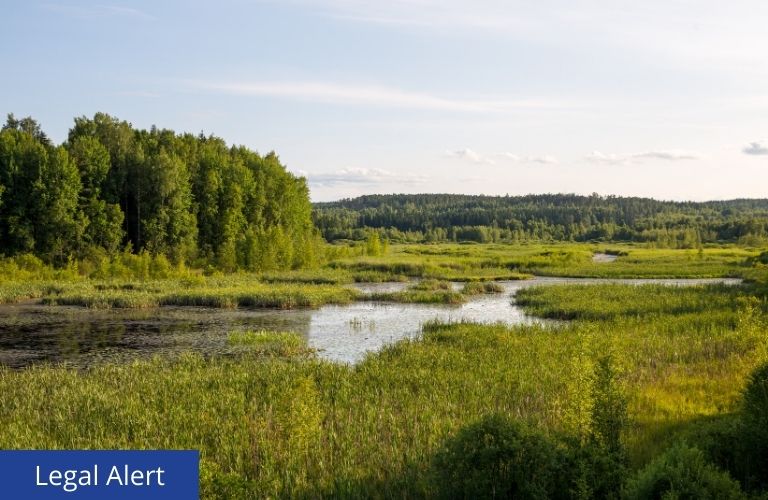
Sackett v. EPA
On May 25, 2023, the U.S. Supreme Court issued a decision in Sackett v. EPA, a closely watched case regarding the jurisdictional reach of the federal Clean Water Act (CWA). Specifically, the Supreme Court addressed the test to be utilized for determining whether wetlands are “waters of the United States” within the scope of the CWA.
In Sackett, the plaintiffs Michael and Chantell Sackett were backfilling their property with dirt and rocks in preparation for building a house when they received a compliance order from U.S. EPA informing them that their backfilling violated the CWA because their property contained wetlands. The order required restoration and threatened civil penalties and the Sacketts filed a lawsuit under the federal Administrative Procedure Act alleging that EPA lacked jurisdiction for its compliance order because any wetlands on their property were not “waters of the United States” under the CWA.
A federal district court in Idaho granted summary judgment to the EPA, the district court’s summary judgment ruling was affirmed by the Ninth Circuit Court of Appeals, and the U.S. Supreme Court granted the Sacketts’ petition for certiorari in order to address the standard for determining which wetlands fall within the regulatory scope of the CWA.
The CWA prohibits the discharge of pollutants into “navigable waters” which the CWA defines as “the waters of the United States.” There has never been any debate that “waters of the United States” include relatively permanent, standing or continuously flowing bodies of waters—such as streams, oceans, rivers, and lakes—as well as certain wetlands adjacent to such water bodies.
Debate on scope of WOTUS
However, there has been considerable debate about the specific scope of “waters of the United States” and which wetlands fall within its meaning, and in Sackett, the Supreme Court described prior regulatory and judicial efforts to determine the precise meaning of the statutory phrase “waters of the United States” as a “persistent problem” that “has sparked decades of agency action and litigation.” Such agency action involved “WOTUS” rules addressing the scope of the CWA which were adopted by the Obama, Trump, and Biden administrations in 2015, 2019, and 2022 and all of which have been subjected to legal challenges by various states and other stakeholders.
In its Sackett decision, all of the justices of the U.S. Supreme Court agreed that the particular wetlands on the Sacketts’ property did not fall within the regulatory scope of the CWA, however, the Supreme Court split 5-4 on the standard to be applied in future cases for determining the particular wetlands protected under the CWA.
The majority rejected the “significant-nexus” standard favored by the EPA and the U.S. Army Corps of Engineers and which arose from Justice Kennedy’s opinion in the Supreme Court’s 2006 decision in Rapanos v. United States. Instead, the majority in Sackett adopted a standard that the CWA only protects wetlands which are “as a practical matter indistinguishable” from traditional waters of the United States Specifically, the Court held that its new, more restrictive test “requires the party asserting jurisdiction over adjacent wetlands to establish first, that the adjacent body of water constitutes waters of the United States, (i.e., a relatively permanent body of water connected to traditional interstate navigable waters); and second, that the wetland has a continuous surface connection with that water, making it difficult to determine where the water ends and the wetland begins.”
The new Sackett standard
Therefore, under the new, narrow Sackett standard, a surface connection must be present in order for a wetland to be considered adjacent to a WOTUS for jurisdictional, regulatory purposes. Presumably, this more, narrow reading of the meaning of “adjacent” will exclude many wetlands where the hydraulic connection to the WOTUS is less than surficial. However, in adopting the more restrictive standard, the majority in Sackett acknowledged that “temporary interruptions in surface connection may sometimes occur because of phenomena like low tides or dry spells” and that “a landowner cannot carve out wetlands from federal jurisdiction by illegally constructing a barrier on wetlands otherwise covered by the CWA.”
As with almost every attempt by the Supreme Court to adopt a “clear” standard in an area involving substantial scientific and ecological complexity, the Supreme Court’s decision in Sackett will not be the final word on the subject and there most certainly will continue to be further agency action, litigation, and ambiguity regarding wetlands regulation and the jurisdictional scope of the Clean Water Act in the future. For more information about Clean Water Act or wetlands issues, please contact Andy Thompson, Steve O’Day, or Phillip Hoover. For a copy of the Supreme Court’s decision in Sackett, click here.

